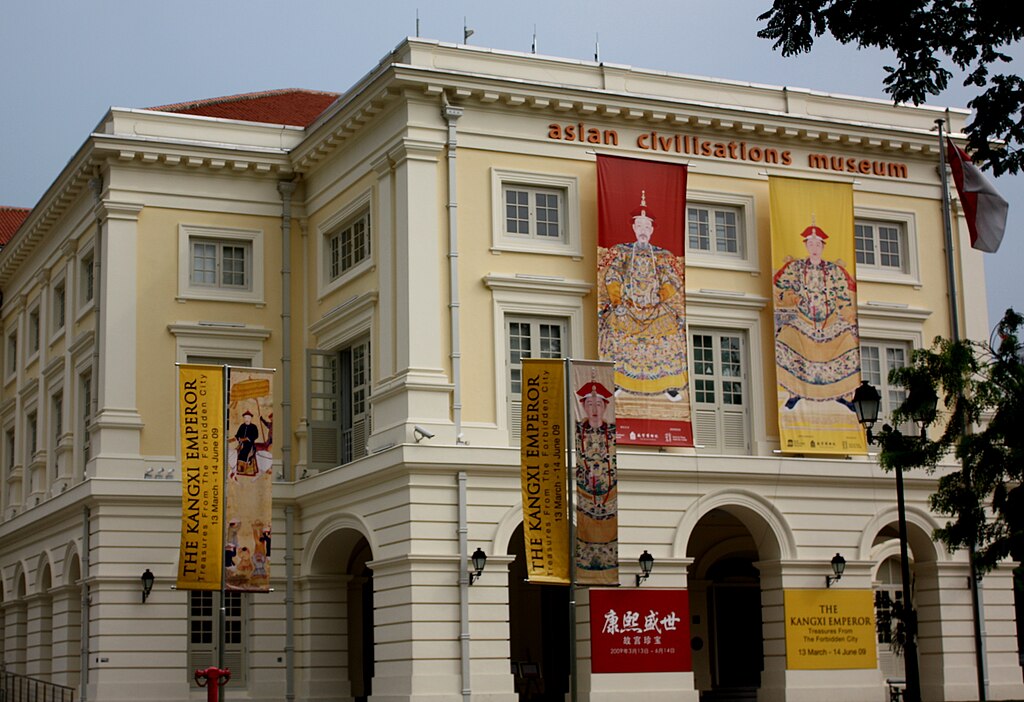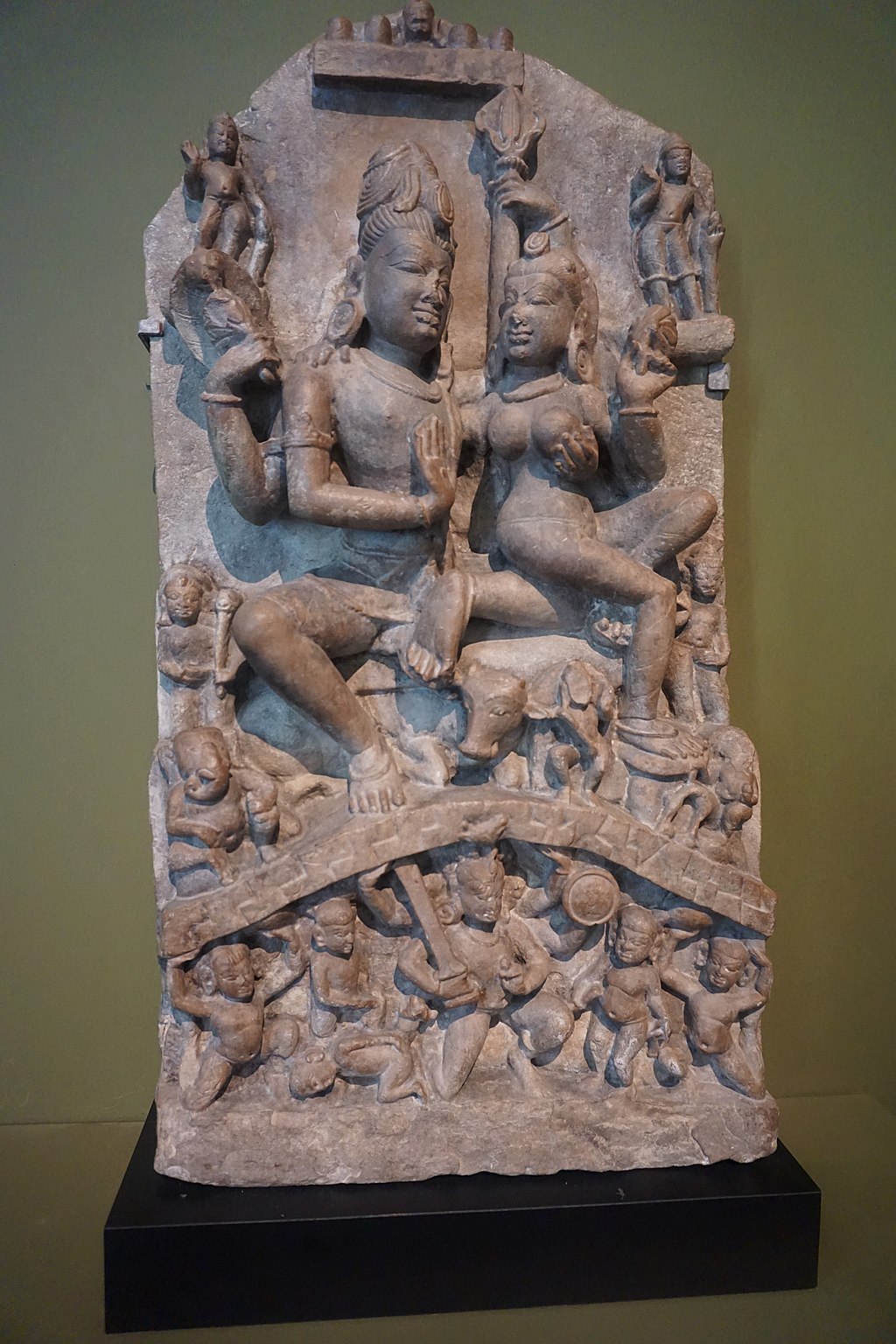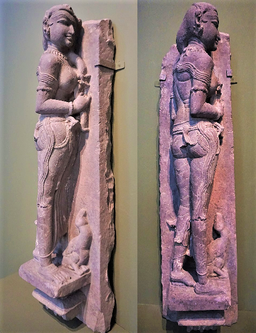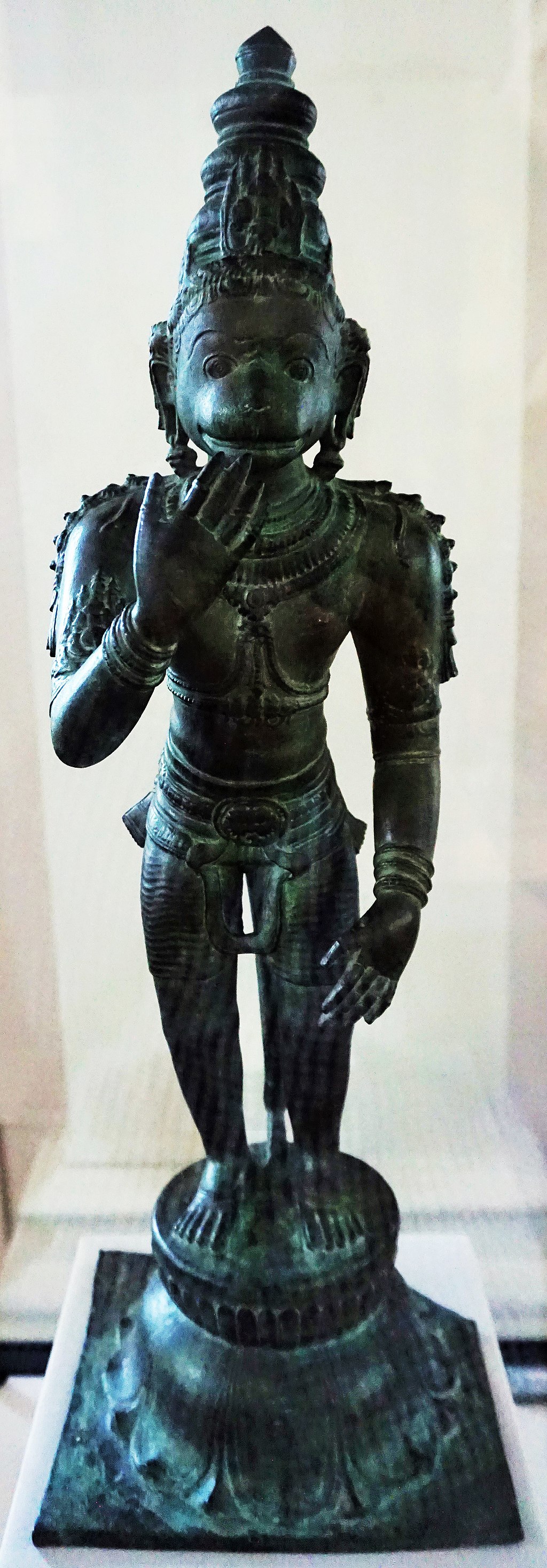
The Asian Civilisations Museum (ACM) is one of the many fascinating museums in Singapore. The Asian Civilisations Museum specializes in Asian cultures and civilizations.
The museum concentrates on the history and art of China, Southeast Asia, South Asia, and West Asia.
ACM fosters an understanding of the diverse heritage cultures of Singapore, their interconnections, and connections with the world.
The various galleries are organized thematically rather than by geographical region. The emphasis of the exhibits is on network and flow influences rather than borders and boundaries.
A Virtual Tour of the Asian Civilisations Museum
- Dancing Ganesha
- Shadow Puppet – Rama
- Bhairava
- The Family of Shiva
- Apsara
- Somaskanda
- Vajradhara and Prajna
- Hanuman
- Walking Buddha
Dancing Ganesha

Dancing Ganesha
This “Dancing Ganesha” is a sculpture full of movement and represents a favorite theme in South Asian art. Ganesha is one of the best-known and most worshipped deities in the Hindu pantheon.
One of the Ganesha stories involves a battle with a powerful demon that had terrorized the gods. One of Ganesha’s tusks was broken during the struggle, which speared the demon and transformed him into a rodent, which can be seen below Ganesha’s right foot.
Accompanying Ganesha is also his entourage of musicians. One of Ganesha’s roles is to entertain his parents, which he does by dancing. Hindu mythology identifies him as the son of Parvati and Shiva.
The act of dancing is related to the perpetual cycle of creation and destruction, that defines the universe and from which humans seek to escape.
Ganesha’s image can be found throughout India, Sri Lanka, Thailand, and Nepal. Commercial and cultural contacts extended India’s influence in Asia, and Ganesha is one of many Hindu deities who consequently reached many foreign lands.
Devotion to Ganesha is widely spread and continues to Jains and Buddhists. Ganesha’s elephant head makes him easy to identify. He is worshipped as the lord of beginnings and as the lord of removing obstacles.
He is also the patron of arts and sciences and the god of intellect and wisdom.
Dancing Ganesha
- Title: Dancing Ganesha
- Dates: 90 – 1000
- Providence: Madhya Pradesh, India
- Materials: Sandstone
- Museum: Asian Art Museum – San Francisco
Bhairava

Bhairava
This statue depicts Bhairava, a Hindu deity, and a fierce manifestation of Shiva associated with annihilation. Bhairava originated in Hindu legends and is sacred to Hindus, Buddhists and Jains alike. He is worshipped throughout India and Nepal.
As a terrifying form of Shiva, he is depicted with bared teeth, wide-open eyes, and flared nostrils. The serpents and skulls on his head add to the fierce image. He is seen in this statue with a skull as a begging bowl in his right hand.
A figure of Bhairavi, his consort sits behind his right shoulder.
Bhairava also represented with the usual attributes of Shiva, such as the drum, a symbol of creation, and time plus the trident.
These features have been damaged in this historical sculpture. Visible is also the ascetic aspect of Shiva, such as the knotted cord around his chest.
Bhairava
- Title: Bhairava
- Dates: 10th century
- Provenience: Uttar Pradesh, India
- Materials: Sandstone
- Museum: Asian Civilisations Museum, Singapore
The Family of Shiva

The Family of Shiva
This sculptured stele shows “The Family of Shiva,” also called “Umamaheshvara,” which is the name for a depiction of the Hindu god Shiva and his wife Uma, also called Parvati.
They are shown tenderly holding each other while a chaotic scene unfolds below. The style of this sculpture is typical of the post-Gupta period in northern India.
This narrative setting shows Shiva seated with one leg raised in a style called “the position of royal ease.” His wife Parvati sits on his knee, and they flanked by their sons, Ganesha and Skanda, as well a by Nandi, the bull that carries Shiva, the sage Bhringi plus attendant figures.
They are all on Mount Kailasha, which the demon Ravana is attempting to shake from under them, in an attempt to take the mountain to his kingdom Lanka.
The narrative shows the power of Shiva, who holds down the mountain with his toes. As he pins down Ravana, Ravana acknowledges Shiva as lord and Shiva in his forgiving grace present to Ravana with a sword as a sign of forgiveness.
The Family of Shiva
- Title: The Family of Shiva
- Dates: 9th Century
- Provenience: North India
- Materials: Sandstone
- Dimensions: 91.1cm
- Museum: Asian Civilisations Museum, Singapore
Somaskanda

Somaskanda
This “Somaskanda” depicts Shiva with his wife and infant son, Skanda, as a family unit. Somaskanda in Sanskrit means “with Uma and Skanda” and originated in the 4th or 5th century as a counter to sects advocating celibacy as the way to salvation.
This representation shows Shiva with four arms with Uma, and between them, the infant Skanda is shown as dancing with ecstasy. This bronze example was made to be carried in festival processions.
The bronze loops on the base were attached to poles so the sculpture could be carried in the festival.
This Indian art imagery is only found in the south of India. Somaskanda is the most popular image of Shiva in southern India in addition to the Linga, being his abstract representation.
Somaskanda
- Title: Somaskanda
- Dates: 1200
- Period: Late Chola
- Provenience: Tamil Nadu, India
- Materials: Bronze
- Dimensions: H: 54.9 cm (Shiva), 51.4 cm (Parvati)
- Museum: Asian Civilisations Museum, Singapore

This statue depicts “Apsara,” a female spirit of the clouds and waters in Hindu and Buddhist mythology. This “water nymph” figure once adorned the exterior wall of a temple in central India.
Her sensuality is believed to attract the gods to hear the prayers of the faithful. The English translations of the word “Apsara” include” “nymph,” “celestial nymph,” and “celestial maiden.”
This masterpiece of Indian art is masterfully carved with her back to the viewer. She turns to one side as the swan eagerly waits for the water drops that she wrings from her hair. In Indian mythology, Apsaras are beautiful and supernatural female beings.
They are young and elegant and expert in the art of dancing. As ethereal beings who inhabit the skies, and are often depicted taking flight and they may be compared to angels.
Apsara
An Apsara is a female spirit of the clouds and waters in Hindu and Buddhist culture. They figure prominently in the sculpture, dance, literature, and painting of many South Asian and Southeast Asian cultures.
They are often wives of the Gandharvas, the court musicians of Indra. They dance to the music made by the Gandharvas, usually in the palaces of the gods, entertain and sometimes seduce gods and men.
Apsaras are said to be able to change their shape at will and rule over the fortunes of gaming and gambling. Apsaras are sometimes compared to the muses of ancient Greece, with the 26 Apsaras at Indra’s court representing a distinct aspect of the performing arts.
They are associated with fertility rites.
Apsara in the Visual Arts
- China
- Apsaras are often depicted as flying figures in the mural paintings and sculptures of Buddhist cave sites in China. They may also be represented as dancers or musicians. They are referred to as “feitian” in Chinese.
- Java and Bali, Indonesia
- Images of Apsaras are found in several ancient Java Temples. The Apsara celestial maidens are decorative motifs or also as integral parts of a story in bas-relief.
- Cambodia
- Angkor Wat, the largest Angkorian temple (built AD 1116–1150), features apsaras. The Angkor Wat artists employed small apsara images (30–40 cm) as decorative motifs on pillars and walls.
- The bas-reliefs of Angkorian temples became the inspiration of Khmer classical dance. This Cambodian ballet-like performance art is frequently called “Apsara Dance.” The dance was created in the mid-20th century.
- The role of the Apsara is danced by a woman, wearing a tight-fitting traditional dress with gilded jewelry and headdress modeled after Angkor bas-reliefs. The dancer’s graceful, sinuous gestures are codified to narrate classical myths or religious stories.
- Champa
- Apsaras were also an essential motif in the art of Champa, medieval Angkor’s neighbor to the east along the coast of what is now central Vietnam. The depictions of apsaras in the Cham art style flourished in the 10th and 11th centuries AD.
Buddhism and Hinduism
Buddhism and Hinduism have common origins in the Ganges culture of northern India around 500 BCE. They have shared parallel beliefs that have existed side by side but also have significant differences.
Buddhism attained prominence in the Indian subcontinent due to the support of the royal courts, but started to decline and virtually disappeared from India in the 11th century CE, except in some small pockets of India.
Buddhism has continued to exist and flourished outside of India and has become the dominant religion in several Asian countries. Many examples exist of temples dedicated to both faiths, including Angkor Wat.
Robam Tep Apsara
Robam Tep Apsara or the Dance of the Apsara Divinities is the title of a Khmer classical dance created by the Royal Ballet of Cambodia in the mid-20th century.
A woman plays the Apsara in tight-fitting traditional dress, whose graceful, sinuous gestures are codified to narrate classical myths or religious stories. The costumes of the apsara role are based on the depicts of Angkor Wat. They wear a silk brocade that is intricately pleated in the front.
Apsara
- Title: Apsara
- Dates: 10th Century
- Period: Chandella
- Provenience: Madhya Pradesh, India
- Materials: Sandstone
- Museum: Asian Civilisations Museum, Singapore
~~~
Vajradhara and Prajna

Vajradhara and Prajna
This “Vajradhara and Prajna” gilded copper statute from the 14th or 15th century, shows the Tibetan Buddhist deity Vajradhara in union with Prajna, who symbolizes wisdom.
The Buddha sits in the meditation posture, with the female deity embracing him. Their faces reflect harmony, their noses, lips, and chins touch in deep serenity.
Vajradhara is seated in a yogic meditation posture with his crossed hands hold identifying attributes of the thunderbolt scepter denoting clarity of mind and the prayer bell associated with wisdom. Their union represents the attainment of knowledge.
Vajradhara
Vajradhara is the ultimate primordial Buddha, or Adi Buddha, according to schools of Tibetan Buddhism. In the evolution of Indian Buddhism, Buddha Vajradhara gradually displaced the ‘Primordial Buddha’ in the ‘Ancient School.’
Vajradhara is a form of the historical Buddha found in Esoteric Buddhism. Vajradhara means “holding a vajra or thunderbolt,” which represents the highest state of enlightenment.
Prajñā
Prajñā or “wisdom” is an insight into the true nature of reality, namely, primarily impermanence, dissatisfaction or suffering, non-self, and emptiness. Prajnaparamita holds a curved knife and skullcup.
Tibetan Buddhism
Tibetan Buddhism is the form of Buddhist doctrine and institutions found in the regions surrounding the Himalayas and much of Central Asia. It derives from the latest stages of Indian Buddhism.
Today, Tibetan Buddhism is adhered to widely in the Tibetan Plateau, Mongolia, northern Nepal, Kalmykia, Siberia, the Russian Far East, and northeast China. It is the state religion of Bhutan.
The Indian regions of Sikkim and Ladakh, both formerly independent kingdoms, are also home to significant Tibetan Buddhist populations, as are the Indian states of Himachal Pradesh, West Bengal, and Arunachal Pradesh.
Vajradhara and Prajna
- Title: Vajradhara and Prajna
- Dates: 14th or 15th Century
- Provenience: Nepal or Tibet
- Materials: Gilded Copper Alloy
- Dimensions: H: 22.8 cm
- Museum: Asian Civilisations Museum, Singapore
~~~
Dancing Ganesha

Dancing Ganesha
This “Dancing Ganesha” is a sculpture full of movement and represents a favorite theme in South Asian art. Ganesha is one of the best-known and most worshipped deities in the Hindu pantheon.
This sculpture depicts Ganesha’s role as leader of the boisterous and playful ganas or dwarf follower of Shiva. Two ganas play instruments on either side of the Ganesha and the mouse sits at his feet.
Ganesha’s image can be found throughout India, Sri Lanka, Thailand, and Nepal. Commercial and cultural contacts extended India’s influence in Asia and Ganesha is one of many Hindu deities who consequently reached many foreign lands.
Devotion to Ganesha is widely spread and extends to Jains and Buddhists. Ganesha’s elephant head makes him easy to identify.
He is worshipped as the lord of beginnings and as the lord of removing obstacles, the patron of arts and sciences, and the god of intellect and wisdom.
Ganesha Iconography
Ganesha is a popular figure in Indian art. Ganesha images first became prevalent in India in the 6th century, and representations of Ganesha have varied widely and have changed over time. He may be portrayed standing, dancing, fighting demons, playing with his family, or engaging in a range of activities.
Ganesha has the head of an elephant, and a big belly and his statues have four arms. He holds his broken tusk in his lower-right hand and his lower-left hand he holds a delicacy, which he samples with his trunk.
In other versions, Ganesha holds an axe or a staff in one upper arm and a noose in the other arm.
Dancing Ganesha
- Title: Dancing Ganesha
- Dates: 910
- Provenience: Madhya Pradesh, India
- Materials: Sandstone
- Museum: Asian Civilisations Museum, Singapore
Shadow Puppet – Rama

Shadow Puppet – Rama
This “Shadow Puppet” depicts Rama, the lead character from the Indian epic, the Ramayana. It is a form of shadow puppet show called Togalu Gombeyaata unique to the state of Karnataka, India. Togalu Gombeyaata translates to “a play of leather dolls” in the native language of Kannada.
Shadow puppetry is an ancient tradition. Performances usually included music, song, and dialogue set against a screen with intense light from behind the puppets to cast a distinct shadow.
The stories were drawn from famous Indian epics such as the Ramayana and Mahabharata, or myths, legends, and traditional storytelling.
The puppets are made of leather, with goat or deer skins used since they have the characteristic of transparency and can be easily colored. The colors are vegetable dyes of red, blue, green, and black.
The hide is cut into appropriate shapes that are joined together using strings and sticks. The puppets represent god, human, and animal figures, where the head and limbs are joined in such a way that they can be moved easily.
A stage is set up using a white semi-transparent cloth strung across the stage to serves as a screen on which the images of the puppets are projected using a bright oil lamp placed behind the puppets to project their images onto the screen.
The puppeteers sit behind the screen and manipulate the puppets to relate the story in the dialogue and songs.
Shadow puppets were a historic art form and tradition for dramatizing the vastly rich cultural epics. It is now mostly superseded by motion pictures and television; however, these puppets provide tangible evidence to the history of South Asian art and drama.
This shadow puppet depicts Rama, also known as Ramachandra, who is a principal deity of Hinduism. In the Rama-centric traditions of Hinduism, he is considered the Supreme Being.
Shadow Puppet – Rama
- Title: Shadow Puppet – Rama
- Dates: 19th Century
- Provenience: Karnataka, India
- Materials: Leather
- Museum: Asian Civilisations Museum, Singapore
Hanuman

Hanuman
This bronze sculpture depicts Hanuman, who is the devoted monkey general of Rama. He is one of the central characters in the various versions of the Indian epic Ramayana.
He is also mentioned in several other texts, such as the Mahabharata, the various Puranas, and some Jain, Buddhist, and Sikh texts.
Hanuman takes the form of a human with a monkey head. He has a monkey-like posture and a tail. His hand placed in front of his mouth symbolizes humility.
He is also a popular figure in legends and arts found outside the Indian subcontinents such as in Myanmar, Thailand, Cambodia, Malaysia, and Bali Indonesia.
Hanuman
- Title: Hanuman
- Dates: 12th century
- Period: Chola
- Provenience: Tamil Nadu, India
- Materials: Bronze
- Dimensions: H: 63.5 cm
- Museum: Asian Civilisations Museum, Singapore

This “Walking Buddha” is a three-dimensional sculpture representing the transcendent qualities innovated in the Sukhothai period.
The Kingdom of Sukhothai was an early kingdom in north-central Thailand from 1238 to 1438. Sukhothai is derived from Sanskrit, and means “dawn of happiness.” This simply clad Buddha figure steps forward in smooth fluid motion with the right hand in the gesture of fearlessness.
This image depicts the Buddha walking back and forth in meditation. This sculpture displays the ideal features and marks that are prescribed in the Buddhist doctrine of the period, which includes:
- an egg-shaped head
- eyebrows like drawn bows
- a nose shaped like a parrot’s beak
- a lion-like torso
- lotus petal-shaped eyelids
- chin in the shape of the mango seed
- arms like a young elephant’s trunk
The dynamic walking posture with arms like a young elephant’s trunk, the tapering fingers, the fitted robe with flowing hemline, and the raised hand accentuate the sense of motion.
The pose represents the Buddha’s walking meditation after his enlightenment.
Walking Buddha
- Title: Walking Buddha
- Dates: 15th or 16th century
- Providence: Sukhothai, Thailand
- Materials: Bronze
- Dimensions: H: 117 cm
- Museum: Asian Civilisations Museum, Singapore
Buddhist Values
The Basic Teachings of Buddha which are core to Buddhism, in a highly simplified form are:
- The Three Universal Truths
- The Four Noble Truths
- The Noble Eightfold Path
The Three Universal Truths are:
- Nothing is lost in the universe
- Everything Changes
- The Law of Cause and Effect
The Four Noble Truths explore human suffering.
- Suffering exists. Life is suffering.
- There is a cause of suffering. Suffering is due to attachment.
- There is an end to suffering. Attachment can be overcome.
- To end suffering, you must follow the Eightfold Path.
Asian Civilisations Museum
- Name: Asian Civilisations Museum
- City: Singapore
- Inaugurated: 1997
- Type: Southeast Asian, South Asian, West Asian and East Asian Heritage
- Location: 1 Empress Place, Singapore
A Tour of Museums in Singapore
- Asian Civilisations Museum
- National Museum of Singapore
- National Gallery of Singapore
- Changi Museum
- Changi Museum
- Old Ford Motor Factory
- Peranakan Museum
- ArtScience Museum
- Buddha Tooth Relic Temple and Museum
- Singapore Philatelic Museum
- Chinatown Heritage Centre
- The Battle Box
Buddhist Quotes
~~~
“Give, even if you only have a little.”
~~~
“If you knew what I know about the power of giving, you would not let a single meal pass without sharing it in some way.”
~~~
“Learn this from water: loud splashes the brook, but the ocean’s depth is calm.”
~~~
“Attachment leads to suffering.”
~~~
“May all beings have happy minds.”
~~~
“Born out of concern for all beings.”
~~~
“I am the miracle.”
~~~
“You only lose what you cling to.”
~~~
“A jug fills drop by drop.”
~~~
“One who acts on truth is happy in this world and beyond.”
~~~
“Every human being is the author of their own health or disease.”
~~~
“The tongue like a sharp knife… Kills without drawing blood.”
~~~
“Drop by drop is the water pot filled. Likewise, the wise man, gathering it little by little, fills himself with good.”
~~~
“I never see what has been done; I only see what remains to be done.”
~~~
“Delight in meditation and solitude. Compose yourself, be happy. You are a seeker.”
~~~
“Ardently do today what must be done. Who knows? Tomorrow, death comes.”
~~~
“Purity and impurity depend on oneself; no one can purify another.”
~~~
“What you are is what you have been. What you’ll be is what you do now.”
~~~
“If you propose to speak, always ask yourself, is it true, is it necessary, is it kind.”
~~~
“You only lose what you cling to.”
~~~
“The past is already gone; the future is not yet here. There’s only one moment for you to live.”
~~~
“The trouble is, you think you have time.”
~~~
“There is no fear for one whose mind is not filled with desires.”
~~~
“Even death is not to be feared by one who has lived wisely.”
~~~
“Irrigators channel waters; fletchers straighten arrows; carpenters bend wood; the wise master themselves.”
~~~
“Those who speak aloud are boastful. Those who speak softly are unsure. Those who don’t speak are dangerous.”
– Singaporean / Malay Proverb
~~~
With Acknowledgement and Thanks to Asian Civilisations Museum for permission to use their Images and Gallery Highlight Descriptions.
Photo Credit: By WolfgangSladkowski [CC BY 3.0 (http://creativecommons.org/licenses/by/3.0)], via Wikimedia Commons
Popular this Week








 Sponsor your Favorite Page
Sponsor your Favorite Page SEARCH Search for: Search Follow UsJoin – The JOM Membership Program
Sponsor a Masterpiece with YOUR NAME CHOICE for $5
Share this:
- Tweet
